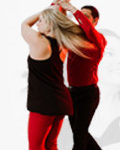Have you watched how great dancers can change direction with incredible speed? Most beginners try to replicate that effect by throwing themselves through the move, but they end up off balance. Actually, the key to direction changes is to finish the previous movement. This drill will help you finish movement by settling into the connection so that you can create that same energy.
The Drill: With a partner, dance a left side tuck turn. As you dance the tuck, try two different ways of dancing.
First, the follower should try to cut her rotation short as she turns into the leader’s hand on 3&. In other words, the follower should remain more linear rather than turning to face the leader. This will result in less compression into the leader during the tuck.
In the second version, the follower should turn to face the leader on 3& more than normal. This will require the follower to rotate more as she exits the tuck, and will create more compression during the tuck. Leaders, you need to make sure that you maintain your frame so that she has something to compress into.
Which version feels easier? If you are both giving compression during the tuck, the second version should actually be easier even though the follower has further to rotate. The reason it should feel easier is because the follower can work off of the energy of the compression rather than having to power herself through the rotation.
Beginning followers tend to make things harder on themselves because they cut their tuck short rather than finishing the compression movement. Beginning leaders tend to exacerbate the situation by not providing a solid platform for the follower to compress into. The key for followers is to learn how to finish the compression without over-committing and losing the momentum of the movement. For leaders, the key is learning how to provide a point for the follower to compress into without being too abrupt: your frame needs to absorb the energy and enable her to redirect, rather than making her feel like she is slamming into a wall.
The drill is to practice the tuck motion slowly in order to figure out when the compression has reached its natural release point. As both of you compress into the tuck, you will feel a point at which your bodies want to spring back. This point will vary depending on your builds, the relation of your centers, etc., so you are not looking for a specific position. Instead, try to feel when that point occurs.
You should feel like your body is a compression spring—it moves as it is pushed, but as it is pushed further the resistance increases. Your frame needs to relaxed enough that you can compress without feeling like you’re hitting a wall, but you need enough tone through your frame that you build resistance.
Keep practicing until you can consistently find that point of natural release. Getting to that point is how you finish your movement into compression.
[mediacredit inline=”FALSE”]




 Brian & Megan
Brian & Megan